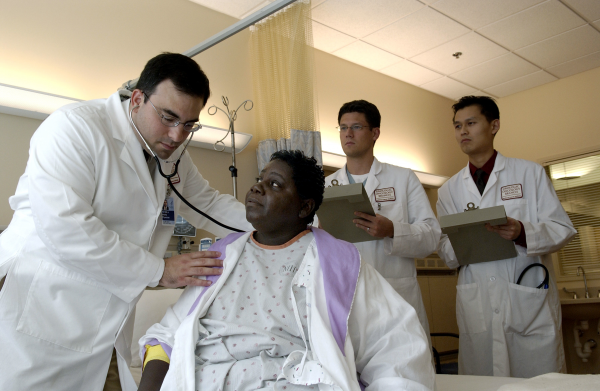Genes Contribute to Population-Based Differences in Antidepressant Response
5 Questions with Dr. Francis McMahon

Genetic factors contribute to antidepressants' lack of effectiveness for many African American patients, according to research led by NIH senior investigator Francis McMahon.
Depression is one of the most common mental health conditions in the U.S., affecting nearly seven percent of American adults each year. With the increasing social and economic pressures of the modern world likely contributing to depressive symptoms, it is more important now than ever to study depression and the factors that contribute to recovery.
A number of variables contribute to an individual’s overall mental health and response to treatment, including elements of nature and nurture that have long been studied at the NIH. In a 2013 study, researchers led by IRP senior investigator Francis McMahon, M.D., set out to understand the complex genetic factors that he believed might help explain why antidepressants are less effective for African Americans with depression than for other populations. His research revealed that differences in socioeconomics and health explained most of those differences in antidepressant response, and the remaining differences were explained by differences in genetic ancestry, rather than self-reported race. The discovery that genetics play a role in this health disparity could help close the gap and improve depression treatment for African Americans.
In recognition of National Depression Screening Day on October 10, I spoke with Dr. McMahon about that study, the origins of his interest in the connection between genetics and depression, and how his work could help lead to better treatments for African Americans with depression.
Why did you choose to study population-based differences in the response to antidepressants?
“I am trained as a psychiatrist and for the first half of my career I was involved in patient care in an effort to help people with depression and other mood disorders. During this point in my career, like most psychiatrists, I was puzzled by the fact that some people with depression did very well when prescribed antidepressant medication, while others did not. During this time, I also observed, like research has shown, that people from disadvantaged minority groups often didn’t do as well when treated for depression as other groups. The question that was always on my mind is ‘What’s going on here?’
“Then, the STAR*D study was carried out and published. This was a large study, consisting of over 4,000 people, and it was meant to investigate how well antidepressants worked, whether other commonly used additional treatments were helpful for people who did not respond to standard antidepressants, and if patient characteristics influenced the effectiveness of antidepressants.
“My team had the opportunity to become involved in the study and look at the genetics of those involved. We studied a number of common genetic markers to understand if they differed in individuals likely to respond to antidepressants versus those who did not respond well. Meanwhile, the STAR*D study had shown that people who described themselves as non-white, such as Hispanics or African Americans, did not respond as well to antidepressants as those who described themselves as white. It occurred to us that we could finally begin to answer our original question of ‘What’s going on here?’ through genetic tools.”
How has this research influenced depression treatment, particularly in relation to minority groups?
“I’d like to think that our research has contributed to an ongoing discussion about several important things. First, treatments for depression need to be tested in people of diverse backgrounds. Until the last decade or so, many Phase 2 and Phase 3 clinical trials were primarily carried out in people of European ancestry who described themselves as white. So, in effect, medications were put on the market when they worked in one group of people, even though the same medications weren’t necessarily as effective in people from different backgrounds.
“This is important because there are important differences in how drugs are processed by the body based on ancestry. For example, people whose bodies process drugs more slowly may be more likely to experience side effects. On the other hand, those whose bodies process drugs more quickly might have a harder time achieving a therapeutic dose. Overall, we need more diversity in clinical trials.

Dr. Francis McMahon
“Second, we published a follow-up paper exploring why more people from minority groups dropped out of clinical trials like STAR*D. We found that African Americans who were dissatisfied with their treatment were more likely to drop out. This suggested to us that clinical trials should emphasize patient engagement and satisfaction at the earliest stages of the study.
"Other research has shown that people who self-describe as belonging to a minority group actually do better in their psychiatric and general healthcare when they have access to a diverse group of care providers. The science behind this phenomenon is unclear, but in psychiatry we believe it is related to the formation of a therapeutic alliance between patients and their psychiatrists. A therapeutic alliance is a relationship between the two where the patient is willing to trust the psychiatrist and what he or she recommends. In return, the psychiatrist understands the patient and takes his or her concerns into consideration.
“We know that when the therapeutic alliance is not strong, patients are less likely to get better, largely due to people dropping out of psychiatric treatment, finding it harder to persist with treatment when there are side effects, and generally feeling less supported by their psychiatrist as they recover. It’s not just about the antidepressant medication. It’s also about the supportive therapeutic relationship that develops with a patient’s treating psychiatrist.”
What was the most challenging aspect of this study?
“I believe that the most challenging aspect of this study was working with a data set that was already completed when we began studying genetics. The STAR*D study was not designed to look at the genetic aspects of participants and how those aspects might impact their antidepressant response outcomes. Rather, we had to make do with the data we had on-hand.
“Another challenging aspect of studying these sorts of data is that we had to make categorical decisions about response and non-response to antidepressants based on various rating scales that patients filled out without having the opportunity to meet with them in person and gain an overall sense for how the patients feel they were doing during treatment. As a clinical psychiatrist, I put a lot of weight into how people appear to be doing when I see them and less weight into how they might answer a questionnaire. However, when you’re working with a data set of over 4,000 people, you have to use the information provided by the questionnaires, even though you may feel as though you’re not getting a full sense of the patients as people and how they’re responding to treatment.”
Were there any particular tools or collaborations that were important in conducting this research?
“One of the challenges of research in mental health is that we study multiple different variables that are correlated to each other and there are a variety of different statistical techniques that can be used to sort out the ‘web’ of correlated variables in an effort to identify what variables are the most important and to understand the relationships among them. We had the opportunity to collaborate with a statistician at Johns Hopkins University, Brion Maher, who was very helpful in guiding us through the modeling that we used to sort out what were the most important predictors of antidepressant resistance, such as race, genetic ancestry, or the other factors we were considering.
“At the time, it was also very helpful to have access to some of the world’s earliest available reference panels. These panels were built upon genetic information obtained from people of distinct ancestries, such as European, African, or Asian. The panels allowed us to map out parts of the genome that were more similar to people of European ancestry or more similar to those of African ancestry. Had we conducted this study a few years earlier, it would have been very difficult, or impossible, to tease out genetic differences that could be explained by differences in ancestry.”

Dr. McMahon is now working with Dr. Carlos Zarate (pictured above) to study genetic risk factors for treatment-resistant depression.
How have you continued to study this topic, and what are your plans to study it in the future?
“Since the STAR*D study, we have gotten interested in studying those who have the hardest time recovering from depression. They are at the highest risk for suicide and chronic disability and constitute a substantial portion of all people who seek treatment for depression. This form of the illness is known as ‘treatment-resistant depression.’ However, I prefer to think of it as depression for which our available treatments have failed and put the blame on us for not curing the illness. Many people with treatment-resistant depression have, in the past, either been forced to live with the disease or seek treatment such as electroconvulsive therapy. This is very effective but often does not last and may have substantial cognitive side effects. We’ve been working with Dr. Carlos Zarate’s group here at the NIH’s National Institute of Mental Health, as well as with a few outside groups to study the genetic risk factors that accompany treatment-resistant depression.
“Instead of focusing on the common genetic differences, we’re using newer genetic technologies that give us information on rare genetic differences, some of which may interfere with usual antidepressant treatments. Today’s treatments were designed to work in most people, most of the time. Common genetic differences seem to be a logical thing to look at in that situation. However, when we find a group of people who are not like most people because their depression persists despite extensive treatment, then we start to think that they may carry some rare genetic differences that get in the way of our ability to treat their depression.
“We’re using a technique called exome sequencing to look at this now. Through this technique, we’re able to pull information on all of the genes in the genome and compare genes in people whose depression responded well to usual treatments to genes in people who suffer from treatment-resistant depression. These kinds of studies need large sample sizes, so we’ve been slowly accumulating the sample size we need. We’re hoping to put together an update on the first 1,000 or so study participants in the next year.”
Head over to our Accomplishments page for more information on Dr. McMahon’s research. You can also subscribe to our weekly newsletter to stay up-to-date on the latest breakthroughs in the NIH Intramural Research Program.
Related Blog Posts
This page was last updated on Wednesday, May 24, 2023
